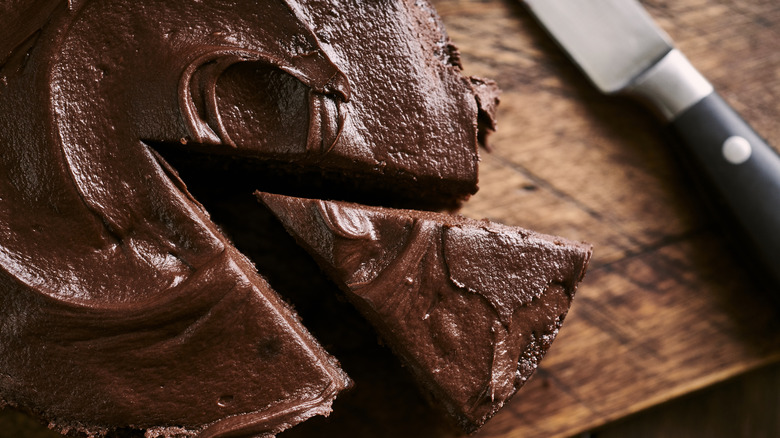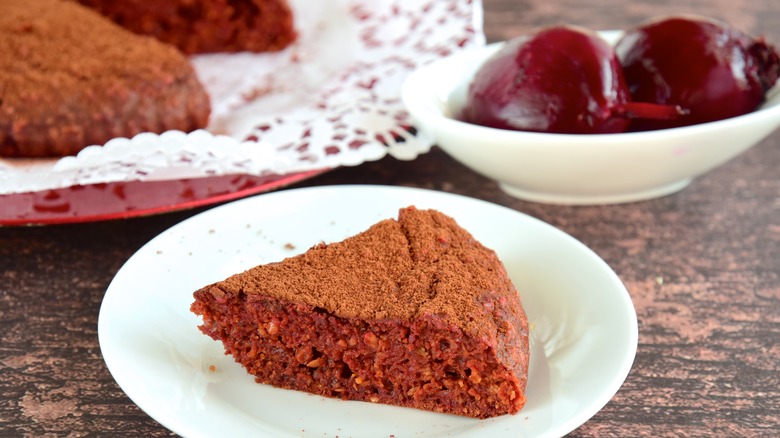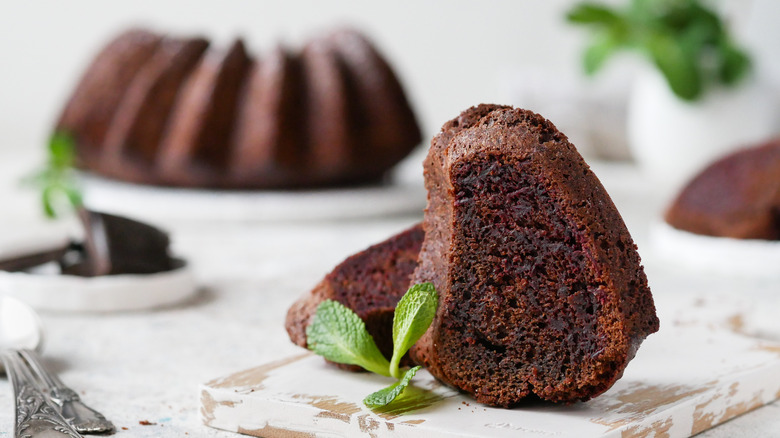The Secret To Moist Chocolate Cake Is Actually A Vegetable
Once you start looking for ways to take your homemade chocolate cake to the next level, you'll find some unexpected ways to kick it up a notch — including but not limited to dark beer, red wine, brown sugar, or even something as simple as hot water. Still, anyone would have to admit that the chocolate cake upgrade that takes the figurative cake of being unorthodox has to go to one old-fashioned secret: The key to a perfectly moist chocolate cake is all in a jar of pickled beets.
While it may sound like a compromise to make your chocolate cake easier on your health at the cost of some sweetness, using canned beets is a hack to create a healthier and tastier treat that almost seems too good to be true. The beets introduce a ton of beneficial antioxidants through their natural red pigments, as well as a good helping of essential vitamins and minerals like folate, manganese, potassium, and iron. It also gives you a moist and decadent texture without any dairy, technically making it a lactose-free hack for chocolate cake. While the exact origins of chocolate beetroot cake are challenging to pin down, it's a certifiably vintage cake recipe that goes back to at least the mid-20th century, if not earlier.
How people might have started using beetroots in chocolate cake
Most discussions on how beetroot chocolate cake might have come about are usually tied to rationing rules during World War II. As the war broke out in the 1940s, the combined factors of interrupted trade routes, labor shortages, military supply priorities, and foreign food aid meant an acute shortage of certain items for civilians in the U.S. during the war and a few years later. Wanting to discourage hoarding and distribute a fair spread of the scarce supply, the government implemented the rationing system that had already been enacted in England — the items placed under ration restrictions included sugar, meats, and dairy products like cheese and butter.
The prevailing theory on beetroot chocolate cake is that it might have been an early version of a red velvet cake made as a "victory cake" — a term that arose during World War II to describe cakes made with as few rationed items as possible. With the earliest published chocolate beet cake recipe being from 1965 — long after the end of WWII — it's difficult to confirm in concrete terms whether this bizarrely well-engineered cake was indeed invented due to rationing restrictions. Still, in the absence of more plausible or well-documented origins to turn to, it seems more than likely: The natural moistness and sweetness added by beets would have been a perfect way of reducing the amount of sugar needed in a recipe as well as cutting out the need for butter altogether.
How does beetroot chocolate cake taste?
Despite any reservations about the naturally earthy taste of beets or the tanginess of pickled vegetables, the near-unanimous sentiment from anyone trying beetroot chocolate cake is that it's a simply fantastic recipe. The telltale "root" taste is subtle enough that one would have to actively be on alert to taste it. Meanwhile, the sour pickled taste translates as a pleasant tang, not unlike what you might taste from buttermilk-involved recipes. From a chemistry perspective, the beets are an incredibly efficient ingredient in the entire cake — from adding natural sweetness to a richness that replaces the need for butter. It also introduces the acids necessary to activate the baking soda to achieve a soft, airy texture on top of the already moist crumb.
The primary way of incorporating beet into your chocolate cake is to purée a can of pickled beets and use it in tandem with either vegetable shortening or vegetable oil in place of the dairy elements in your cake. While most traditional recipes include egg (as well as heavy cream in the ganache or frosting), you can simply take it out to make a completely vegan chocolate beet cake. Because the beets and baking soda do most of the texture work, adding vinegar, cornstarch, and baking powder should be enough to compensate for the lack of eggs.


